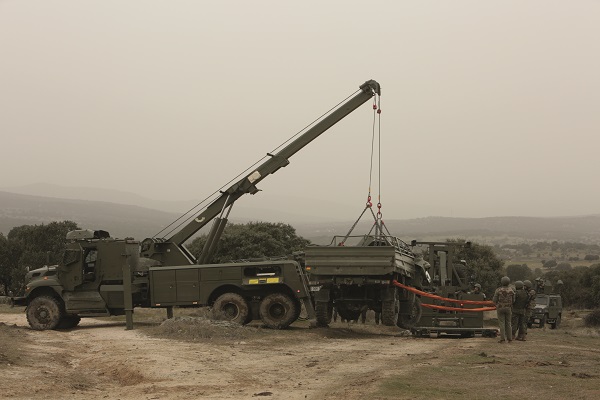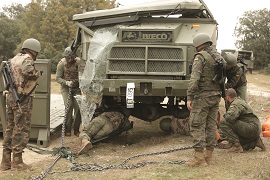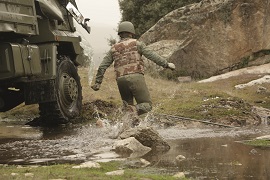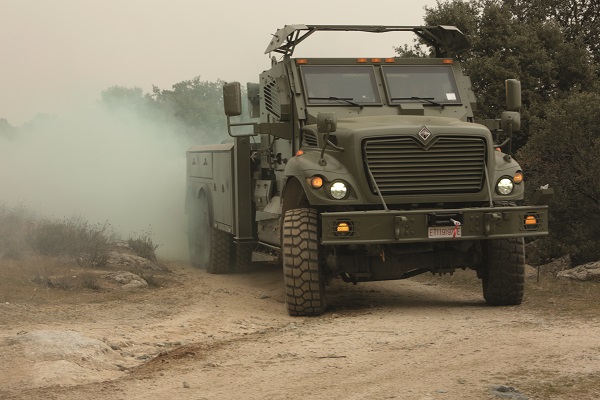- Home
- Feature Articles
- Recuperacion en ambiente hostil
Recovery in a hostile environment
Tuesday, March 28, 2017
Number: 43
Experts say that there is no such thing as a bad recovery, as long as the aim of removing the trapped or broken-down vehicle is achieved. However, this aim changes slightly when the optimum security conditions of the specialist teams are lacking, which often happens in operations zones. In these cases, a "good and quick" recovery is needed, explains 1st sargent Lucio, from the 11th Logistic Support Force (in Spanish: Agrupación de Apoyo Logístico, AALOG), one of the instructors at the most recent "Recovery in Hostile Environments" Conference, which took place from 13th to 24th February at the “San Pedro” base in Colmenar Viejo (Madrid).

Moment in which the Maxxpro raises the damaged truck to place it onto the VEMPAR platform, which will then take it away from the danger zone
The event has been organisaed since 2011, launched by the Logistics Brigade, and aims to improve the preparations of recovery teams who are deployed in the international missions in which Spain participates. This is because recovering a broken-down military vehicle on the hard shoulder of a motorway or a truck in a national exercises field is not the same as working on a recovery when exposed to groups that are hostile towards the Spanish presence on their home territory.

The Recovery team attaching anchors to the truck.

The soldiers have to be prepared for all situations.
Recovery teams have to know how to adapt their procedures when faced with complicated situations, which involves "hooking the vehicle onto something and dragging it to a base or a safe place," added the 1st sargent.
The Conferences have taken place since 2011 and are aimed at people who are going to be deployed in international missions
This is exactly what the members of the AALOG 11 members have to do in their placement along with the theory classes of the course. This Unit was initially in charge of the course, and has become the reference force with regard to this subject within the Army. A few lectures are organised each semester, and the students are members of recovery and transport teams from units that will soon be deployed internationally: NCOs who hold positions in recovery and maintenance teams, as well as army personnel in charge of crane operations, and RG-31, Lince and VEMPAR drivers and operators.
Actual Experiences

The MaxxPro arriving at the action zone.
Among the participants, there were some people who had seen the recovery of a vehicle in a hostile environment. These include 1st corporal Carrasquilla who, along with his team in a logisitcs convoy of nearly 400 vehicles in Afghanistan in 2010, had to recover a lorry that had falled onto an IED, which had destroyed its pneumatic system. "We had to remove it from the death zone with the help of a crane from the US Army, who were also in convoy because we were being shot," he remembered.
1st corporal Tejerina, also in Afghanistan but in 2013, experienced something similar with a RG-31 that was knocked over after an attack on a truck on the Moqur route in Darra-i-Bum. "The course was really good, the situations are very realistic," he added.
ARMY UNITS
- Araba Álava |
- Albacete |
- Alicante |
- Almería |
- Asturias |
- Ávila |
- Badajoz |
- Barcelona |
- Burgos |
- Cáceres |
- Cádiz |
- Cantabria |
- Castellón |
- Ceuta |
- Ciudad Real |
- Córdoba |
- A Coruña |
- Cuenca |
- Girona |
- Granada |
- Guadalajara |
- Gipuzkoa |
- Huelva |
- Huesca |
- Islas Baleares |
- Jaén |
- León |
- Lleida |
- Lugo |
- Madrid |
- Málaga |
- Melilla |
- Murcia |
- Navarra |
- Ourense |
- Palencia |
- Las Palmas |
- Pontevedra |
- La Rioja |
- Salamanca |
- Segovia |
- Sevilla |
- Soria |
- Tarragona |
- Santa Cruz de Tenerife |
- Teruel |
- Toledo |
- Valencia |
- Valladolid |
- Bizkaia |
- Zamora |
- Zaragoza



